|
|
|
Sort Order |
|
|
|
Items / Page
|
|
|
|
|
|
|
| Srl | Item |
| 1 |
ID:
122476
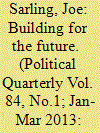

|
|
|
|
|
| Publication |
2013.
|
| Summary/Abstract |
The UK's housing problem has become an economic one. Finding ways to boost the supply of housing across the UK is currently near the top of the Government's economic growth and jobs agenda. As a result of failed policies over the past 60 years - policymakers' unwillingness to tackle NIMBY interests, a complex national planning system, developers' unwillingness and inability to build housing at the volume required to maintain stable prices, changing preferences amongst the population - the scale of the problem is vast. However, for any hope of success for the Government's housing strategy, it is vital to understand the extent to which the housing landscape varies significantly across different parts of the country.
|
|
|
|
|
|
|
|
|
|
|
|
|
|
|
|
| 2 |
ID:
175927


|
|
|
|
|
| Summary/Abstract |
A key obstacle to nuclear energy as a decarbonization policy is the public perception of risks of radiation leaks from reactors. In particular, the “not-in-my-backyard (NIMBY)" syndrome suggests that individuals oppose nuclear reactors in their neighborhoods because they overestimate their risks. Arguably, such perceptions would be acute for those who have lived in the vicinity of a nuclear accident. We conducted a surveyembedded experiment in Japan (N = 2574) to assess how the NIMBY syndrome influences public support for restarting nuclear reactors when health, economic, and climate change benefits of nuclear energy are highlighted. We focus on Japan because the risks of nuclear energy became salient after the 2011 Fukushima accident. We test for two types of NIMBY effect, (1) respondents' proximity to any nuclear power plant and (2) respondents' place of residence in 2011 and its proximity to Fukushima. We do not find support for either the NIMBY syndrome or the Fukushima effect. On the contrary, we find support for a “reverse-NIMBY” among low-income residents, when they are treated with information on nuclear energy's low local air pollution (health). Our findings suggest that support for nuclear energy varies across population groups and depends on how its local benefits and costs are framed.
|
|
|
|
|
|
|
|
|
|
|
|
|
|
|
|
| 3 |
ID:
146888
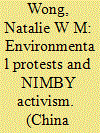

|
|
|
|
|
| Summary/Abstract |
Protests in post-Mao China not only indicate citizens’ increasing dissatisfaction but also challenge the regime to act and take appropriate measures. This article discusses local government response to environmental activism within China’s decentralized political structure. Anti-incinerator protests in Beijing and Guangzhou are used to illustrate the emergence of public participation in municipal policymaking on waste management. The Beijing and Guangzhou governments’ different attitudes and responses to citizens’ grievances are analysed, particularly in light of a new public-consultative waste management mechanism implemented in Guangzhou, the Guangzhou Public Consultation and Supervision Committee for Urban Waste Management (广州市城市废弃物处理公众咨询监督委员会). Changes in policies on waste management and disposal are examined through documentary analysis and in-depth interviews with stakeholders involved in anti-incinerator protests. The main goal here is to demonstrate that policy change is not only determined by protest outcomes, but that it is also greatly affected by the responses of local governments and actors within a framework of advocacy coalition. This study throws new light on Chinese policymaking on environmental issues and it re-appraises studies of environmental management in China.
|
|
|
|
|
|
|
|
|
|
|
|
|
|
|
|
| 4 |
ID:
092771
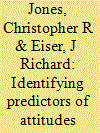

|
|
|
|
|
| Publication |
2009.
|
| Summary/Abstract |
The threats posed by climate change are placing governments under increasing pressure to meet electricity demand from low-carbon sources. In many countries, including the UK, legislation is in place to ensure the continued expansion of renewable energy capacity. Onshore wind turbines are expected to play a key role in achieving these aims. However, despite high levels of public support for onshore wind development in principle, specific projects often experience local opposition. Traditionally this difference in general and specific attitudes has been attributed to NIMBYism (not in my back yard), but evidence is increasingly calling this assumption into question. This study used multiple regression analysis to identify what factors might predict attitudes towards mooted wind development in Sheffield, England. We report on the attitudes of two groups; one group (target) living close to four sites earmarked for development and an unaffected comparison group (comparison). We found little evidence of NIMBYism amongst members of the target group; instead, differences between general and specific attitudes appeared attributable to uncertainty regarding the proposals. The results are discussed with respect to literature highlighting the importance of early, continued and responsive community involvement in combating local opposition and facilitating the deployment of onshore wind turbines.
|
|
|
|
|
|
|
|
|
|
|
|
|
|
|
|
| 5 |
ID:
175160
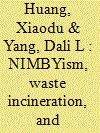

|
|
|
|
|
| Summary/Abstract |
With the world’s largest population and rapid urbanization, China is in the throes of a waste management crisis. Efforts to cope with this crisis through waste incineration have been met with growing NIMBYism as the Chinese public become more environmentally aware and are determined to protect their health and economic interests. We review the turn to incineration and the major characteristics of NIMBYism and ensuing protests against waste incinerators. We then describe the May 2014 Jiufeng incinerator protest in Hangzhou and the subsequent efforts to successfully respond to NIMBYist protests and build the proposed incineration plant on the planned site. The Hangzhou Jiufeng case offers a model for breaking the logjam between development and NIMBYism, leading to important improvements in environmental governance and regulation.
|
|
|
|
|
|
|
|
|
|
|
|
|
|
|
|
| 6 |
ID:
122715
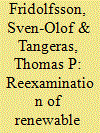

|
|
|
|
|
| Publication |
2013.
|
| Summary/Abstract |
Green certificates are the main instrument for promoting renewable electricity (RES-E) in Sweden. But certificates cover only a limited share of total RES-E production. Under partial coverage, crowding out may arise whereby costly new RES-E replaces inexpensive old RES-E. Granting certificates to all of RES-E production improves efficiency, but leaves windfall rent to otherwise profitable facilities. We also analyze transaction costs in the permit process for new RES-E in Sweden. Municipalities veto socially desirable projects because of asymmetrically distributed investment costs and benefits. We propose market-based permit fees rather than limited veto rights as a solution to this NIMBY problem.
|
|
|
|
|
|
|
|
|
|
|
|
|
|
|
|
| 7 |
ID:
190882
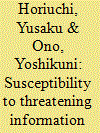

|
|
|
|
|
| Summary/Abstract |
A growing number of news articles and politicians’ statements treat refugees as potential terrorists. However, existing research has yet to thoroughly examine how threatening information about refugees affects natives’ attitudes toward refugee resettlement. To address this issue, we conducted a survey experiment in Japan, where the number of refugees accepted each year is extremely small, despite the rapid increase in news about refugees. Our results show that opposition to refugee resettlement is associated with its proximity. Specifically, we find two types of NIMBY (not-in-my-backyard) attitudes – within-country and between-country NIMBY-ism – toward refugee resettlement among Japanese people. Additionally, respondents become more strongly opposed to refugee resettlement when exposed to threatening frames that depict refugees as harmful, regardless of the proximity to threats and potential resettlement. These findings add nuance to the scholarly literature on threat perceptions and public attitudes in intergroup relations. First, our findings suggest that NIMBY attitudes toward refugee resettlement (shown in Ferwerda, Flynn & Horiuchi, 2017) are not a US-only phenomenon. Second, we provide empirical evidence to support the theory that subjectively perceived threats affect people’s hostility toward out-group members, even in the absence of actual threats. Finally, we contribute to the recent debate on the effects of proximity to threats. Our results support the argument that the psychological effects of terrorism on negative attitudes toward immigrants and refugees are more pronounced in homogeneous societies, irrespective of proximity to the threat.
|
|
|
|
|
|
|
|
|
|
|
|
|
|
|
|
| 8 |
ID:
096151
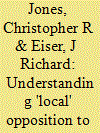

|
|
|
|
|
| Publication |
2010.
|
| Summary/Abstract |
In recognition of the environmental and economic threats posed by climate change; decisive steps are now being taken to stabilise greenhouse gas emissions. One sector receiving particular attention within the UK is that of electricity generation. As such, the government has introduced ambitious targets for increasing renewable generating capacity within the country. Wind turbines are expected to play a significant role in meeting these targets; however, despite high levels of support for the technology in principle, specific projects are often delayed or rejected on account of local opposition. This study aimed to establish how attitudes towards development might vary with respect to increasing distance from the identified sites. Participants were required to register their opinion towards development at a number of on- and off-shore locations in the UK. The results indicated that participants were most favourable to offshore development and least favourable to development at the identified sites. Attitudes to onshore development indicated that so long as a proposed location was anticipated to be 'out of sight' it was considered in relatively general terms. The results are discussed with reference to site visibility and landscape concerns and clearly support calls for a shift towards community-focussed development strategies.
|
|
|
|
|
|
|
|
|
|
|
|
|
|
|
|
| 9 |
ID:
103594
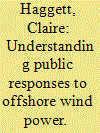

|
|
|
|
|
| Publication |
2011.
|
| Summary/Abstract |
This paper is about understanding the role and importance of public responses to offshore wind power. It builds on a framework for understanding social acceptance and opposition to onshore turbines, and reviews the emerging research on offshore wind. While less is known about how people will respond to offshore than onshore wind, there is now an emerging body of research. From this literature, several common factors which influence responses have emerged and are discussed here: the (continued) role of visual impact; place attachment to the local area; lack of tangible benefits; relationships with developers and outsiders; and the role of the planning and decision-making systems. The paper argues that, as with onshore developments, the public should be included in decision-making about offshore wind farms, and that they have a key role which should not be underestimated. The paper concludes with some thoughts about the means to involve people and how effected communities might be effectively acknowledged, identified and engaged.
|
|
|
|
|
|
|
|
|
|
|
|
|
|
|
|
| 10 |
ID:
115110
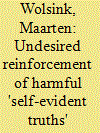

|
|
|
|
|
| Publication |
2012.
|
| Summary/Abstract |
This 'viewpoint' draws attention to a lingering, simplistic and faulty interpretation of the complex phenomenon of acceptance of renewables and their implementation in concrete projects by all relevant actors-namely the 'backyard theory'. During the last decade, research that investigated nimby has provided support to disprove the two prime hypotheses (proximity and decreasing property-value). The current mainstream trend in academic circles is clearly towards abandoning nimby explanations.
However, in practice among developers and policymakers nimby thinking still prevails. Unfortunately there is also some academic writing that persists in recycling the 'backyard theory'-despite ample research to the contrary-thus feeding this faulty interpretation of implementation problems. A recent review of the state of the art of wind power implementation is taken as an example; it presents nimby as a common-sense, self-evident truth, while to support this explanation it cites publications that actually refute this view and instead support the mainstream move towards abandoning nimby thinking. This shift is important, because further academic support for this concept would serve to hinder rapid deployment of wind power and also other renewables.
|
|
|
|
|
|
|
|
|
|
|
|
|
|
|
|
| 11 |
ID:
125420
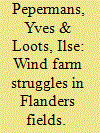

|
|
|
|
|
| Publication |
2013.
|
| Summary/Abstract |
In this article we analyse how protests against wind farms reflect symbolic distances or alienations, typical to Flanders (Belgium), as consequences of wider societal trends. A thorough qualitative study of three wind farm projects in Flanders, including group discussions and interviews with crucial stakeholders, shows that the current siting process reinforces disagreements and leads to a stalemate between different framings of the wind farms. Using insights from our case studies and the literature, we argue for spatial planning which strives for a negotiation over acceptable solutions rather than acceptance of fixed proposals.
|
|
|
|
|
|
|
|
|
|
|
|
|
|
|
|
|
|
|
|
|